One of the core concepts of Plato’s philosophy, is that there is a distinction between the ideal form of something, and the real form of it. No matter how precisely we draw, we can never produce a perfect circle. It is a complex series of theories that weaves through Western thought, and as a student of pizzas, I am sure it can be applied to this circular disk of delights.
We all have a picture in our heads and a lingering taste on our palates, a Platonic Ideal of the Perfect Pizza. It is round, isn’t it? Well, often it is not. It has a puffy crust right? Not always. Tomato sauce? Don’t count on it. Just what is a pizza, then? Is it the Mystic Pizza of movie fame (above)? Perhaps, but more likely, it is built upon the memory of nights out with the family, or Mom’s home made. All other pizzas are relegated to a rank of inferior.
Nobody knows when and where pizza started. Early Syrians and Turks served a round flat bread topped with minced meats called Lahmacun. Greek and Roman soldiers are believed to have cooked dough on their shields over camp fires. Today there are a gazillion variations on the theme, and attempting to categorize the world’s pizzas into species and sub-species is a sure way to start a fight, but I’ve never been afraid to be contentious, so here goes, a family tree of pizzas.
I will begin my Pizza Project with the proposition that it is the makeup and thickness of the crust that defines a species of pizza, and that the infinite combinations of toppings create subspecies.
In other words Neapolitan pizza is a species, while Margherita is a sub-species. Neapolitan pizza is defined by a very specific dough recipe (dictated by law in Italy) and there are many sub-species depending on the toppings. Margherita is the most famous sub-species, with just tomato sauce, cheese, basil, garlic, salt, and olive oil. But Roman pizza, which is a unique species identifiable by a different dough recipe, can also have a sub-species called Margherita made with the same toppings. Still with me?
The good news is that it is not that hard to make great pizzas at home, and, since the best pizzas are cooked in wood or charcoal burning ovens, once we master the concepts, we can cook incredibly good pizzas on our grills. So good you may never be able to eat restaurant pizzas again.
Neapolitan Pizza
Naples is still the go-to for great pizza, where it has been made pretty much the same way for more than a century. There’s even a trade association that certifies pizzerias as “authentic” Neapolitan with guidelines for ingredients and cooking. The dough must be made only with flour, yeast, salt, and water. There is no olive oil in the blend, so it is a very light, soft dough.

A wood burning bell-shaped brick oven is required, with a rock bottom often made of volcanic rock from Mount Vesuvius, a live volcano that hovers over Naples. The pie must be cooked on the floor of the oven and may not be cooked in a pan or container. Logs are pushed to the back and off to the side and there is a low ceiling that allows the flames from the logs to roll over the top of the pie. Temps are at least 750 to 800°F minimum and often soar over 1000°F! That means your meal can be fully cooked in as little as 90 seconds!
The quintessential Neapolitan sub-species is the Pizza Margherita, made with San Marzano tomatoes from Italy, fresh water buffalo mozzarella cheese, and fresh basil, producing the colors of the Italian flag, red, white, and green. Click here for the whole story of the Margherita and a recipe. Above is a typical Margherita made at Spacca Nappoli in Chicago. I like mine with a bit more basil, please. Click here for my Neapolitan dough recipe and more details about the true authentic Neapolitan method.
Roman pizza
In Rome, you can find a wide range of pizza doughs. There are no pizza police as there are in Naples. But if there is a common thread, Roman pizza dough tends to have an airy crust made with olive oil, flour, water, yeast, salt, and occasionally a touch of sugar. The addition of oil is the main distinction from Neapolitan dough and it gives the crust more weight, flavor, and a crispy crunch. Most American pizzas can be roughly categorized as “Roman style” because the dough is roughly the same. Typically Roman style, a.k.a. pizza alla pala, is made on a long board and is sort of rectangular.
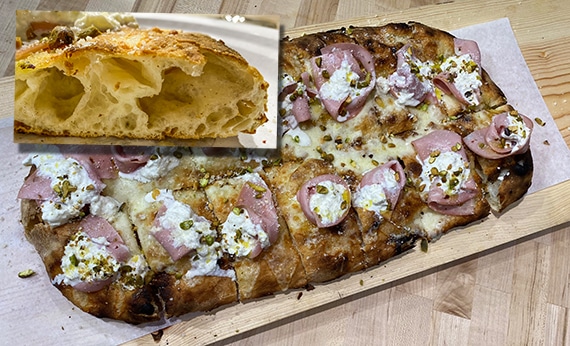
In many Roman shopfronts pizza al taglio (pizza for cutting) is sold by the slice from oiled rectangular sheet pans in which they are cooked. According to Maureen Fant, a Rome-based American food writer whose work appears often in the New York Times, “They are variously topped or not topped at all. They are quite yeasty and delicious. It is my unofficial, unscientific impression that true thin-crust Roman pizza is endangered in Rome. Most new pizzerias make a very yeasty crust, sometimes good, sometimes not.”
Another American born Roman, Iris Carulli, a private tour guide and historian with whom I spent a day in Rome says that the Associazione Panificatori Romani (Breadmakers Association of Rome) has tried in vain to obtain an Identificazione Geografica Tipica classification from the government for Pizza Romana. They keep getting turned down because no one in the Association can agree on the authentic recipe for the dough.
The pizza that is rarely found outside Rome is the pizza bianca, a white pizza that is oblong. Carulli says that it has no tomatoes and it is often annointed with fresh oil immediately after it comes out of the oven. Fant says “The maximum expression of pizza bianca is achieved in summer when you slice the slices open and make a sandwich of peeled very ripe fresh figs and prosciutto.”
According to Fant, common toppings of Roman pizza are uncooked crushed tomatoes, fresh sliced mushrooms, dried oregano, garlic, artichoke hearts, prosciutto, hard boiled egg, olives (for capricciosa pizza), or anchovies (this is called alla Napoletana, while anchovy pizza is called Romana in Naples). Above is a pizza made by Leo Spizzirri of the North American Pizza & Culinary Academy in Lisle, IL, near Chicago. It is topped with mortadella and buffalo mozz. Below is a fresh spinach pizza I had in Rome. Spinach is most certainly not a typical topping.

When in Rome, you may wish to take pizza lessons from Gabriele Bonci at Tricolore, a stones throw from the Vatican. He has been called the Michaelangelo of pizza. Here’s a video of him making a simple pizza. Here he is being creative with what he calls a pizza streudel. Click here for my wife’s Roman style pizza dough recipe.
Sfincione (a.k.a. Sicilian Pizza, a.k.a. Grandma Pizza)
Sicilian pizza, called Sfincione in Sicily and Grandma Pizza by some pizza students in the US, may be among the oldest pizza styles. It is characterized by a square or rectangular spongy crust that can be up to 1″ thick, often crunchy because the bottom is practically fried in a well oiled sheet pan. Typical toppings are products readily available in abbondanza in Sicily: Fresh tomatoes, garlic, oregano, onion, olives, anchovies, and a grated hard cheese, usually pecorino.

This species is probably the antecedent of the Chicago Deep Dish Pan Pizza, and it is common in the kitchens of many Italian Americans descended from Southern Italy descent in the US. This one was made by an Italian-American Grandma, Theresa Tortorello of Elmhurst, IL.
Detroit pizza
A particular type of thick crust pan pizza, Detroit style has been made since at least the 1940s, first created by Gus Guerra and his wife at Buddy’s. The founders were from Sicily so they made a thick crust pizza in a pan. The pans are a little shorter and deeper than your typical 9 x 13″ baking pan, and the well-oiled dark steel crisps up the pizza crust magnificently. The dough tends to be a bit richer than Neapolitan or NY-style dough because there is oil in the blend, which also helps it get crispy on the edges and makes it tender inside. Most important, Detroit style pizza has lots of shredded cheese, especially around the edges, where, as the dough pulls back from the pan the cheese seeps down and the hot pan nearly blackens the cheese, creating an extra crispy, cheesy crust that acts as a sort of built-in Frico, those addictive Italian cheese crisps. The cheese varies from joint to joint, with Wisconsin brick and white cheddar common, often blended with mozz. It is baked twice, once with just the cheese on the dough, then hot sauce is added, then lots of pepperoni (lots) and it is baked again. Because the heat enters from above and below and both sides of the corners, the corner slices are most prized, which is why the smaller pans are best since each slice has a corner. It’s amazing how just a few tweaks turns your basic Sicilian pizza into something different and something so good. For an inkling of this style, try the DEEP!DEEP! pan pizza from Little Caesar’s restaurants or bake one of the DiGiorno Pepperoni Crispy Pan Pizzas at home. Not exactly the same, but a hint. Here’s a picture of the Little Caesar’s pizza

Focaccia
Focaccia (pronounced fo-CA-cha) is usually a thick breadlike pizza dough. It usually has no sauce but a close brush with olive oil, it should never be greasy, it is usually salty, and often garlicy. Prosciutto, a cured ham, is a common topping. You can get creative here, but keep it simple. There’s nothing better than focaccia for mopping up spaghetti sauce or for mangia-ing while watching the game with a beer or glass of wine.
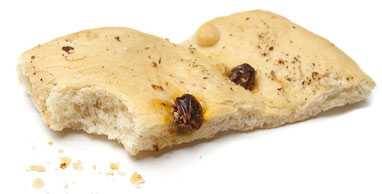
This is a simple focaccia with garlic oil, herbs, sea salt, chipotle powder, and smoked cherry tomatoes. Here is a video of a Focaccia di Recco, an unusual cheese stuffed version made in the Italian region of Liguria.
Calzones, Stromboli, Panzerotti
These are stuffed pizzas. Calzones are made by rolling out a round crust, covering half of it with a thick layer of toppings, folding it over, wetting the edges to help them stick together, crimping them, poking a few holes on top for steam to escape, and then baking. They are usually served with sauce for dipping, even if there is sauce inside. Stromboli are made by rolling a rectangle of dough like a burrito. It is usually sliced to feed multiple mouths. Both usually get painted with egg to make them shiny. Panzerotti are usually deep fried. They are sometimes called calzoni fritti (fried calzones) or pizze fritte (fried pizza). Beware, you can really burn your tongue on these babies. Below is a fine example of a calzone from the famous Mystic Pizza in Mystic, CT, (where they made the movie). I like their calzones much more than their regular pizzas, by the way.
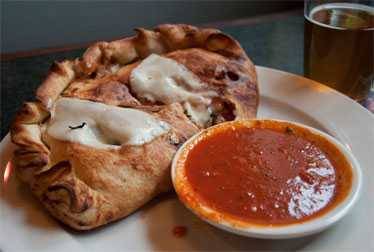
A variation on the theme is the panzerotto, panzerotti, panzarotti. Occasionally found in Italy, they seem to be catching on in the US. In Italy they may be a sweeter dough, and in some pizzerias in the US they are deep fried calzones. Sometimes they are indistinguishable from calzones. Then there is the stromboli, another stuffed dough, sometimes rolled, usually filled with sausage, and often ricotta cheese. Confused yet?
Turkish and Armenian Lahmacun and Pide
There are several unique and similar characteristics to the flatbreads or Armenia and Turkey. Armenian lahmacun (a.k.a. lahmajun, lahmejun, lahmacun, lahmajoun) and Turkish pide (pronounced pea-day) start with a thin dough usually made with yogurt or milk, and usually a bit of sugar and oil.
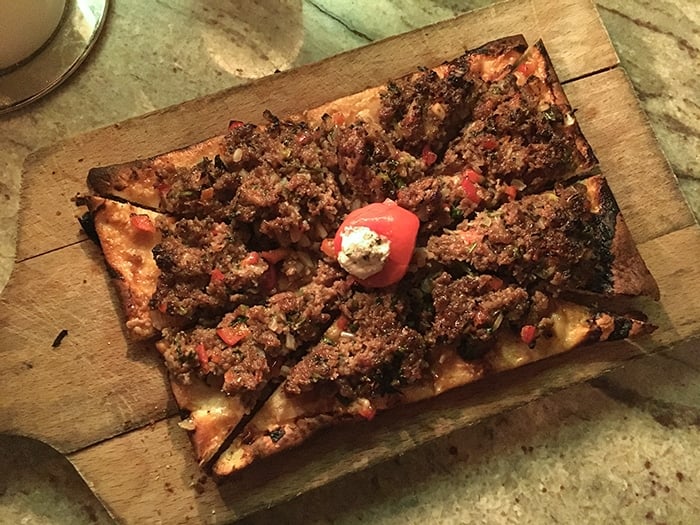
Turkish pide is formed into an oblong shell folded inward to give it rigidity and to help hold in the fillings. Looking like a canoe, it can then be glazed with oil, butter, milk, yogurt and water, or even egg.
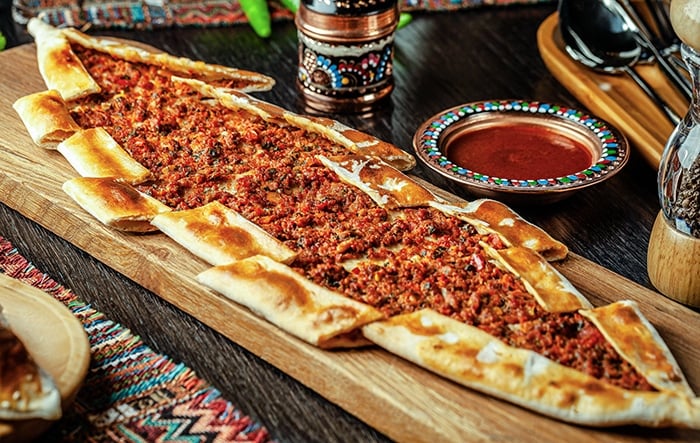
The fillings vary depending on the cook and customer. There is usually no cheese, just chopped, minced, or ground meat, often chicken, lamb, or beef, and spices, pre-cooked and piled thick on the center right on the dough, no sauce layer. Other popular toppings include onion, garlic, tomato paste, dried fruits, coriander, ginger, honey, cinnamon, mint, paprika, hot pepper, and a sprinkle of sesame seeds on top. It can be served with chopped tomato, onion, yogurt, lemon wedges, or even a poached egg and flat versions can be rolled around raw vegetables and pickles. Pide is sold in Turkey in restaurants called pideci. Anybody notice the similarity in the name to pita and pizza?
Provencal Pissaladiere
The French learned to make pizza from the Italians, but put their own twist on it, naturally. In Provence in Southern France, pissaladiere (below) is a sauceless, cheeseless pie on a medium crust, often a no yeast tart crust that is more like a pie crust.
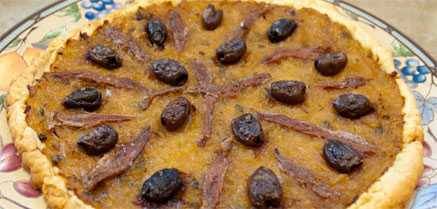
The classic pissaladiere, like the one made by my wife here, is topped with caramelized onions, olives, garlic, anchovies, and herbs. Here’s a recipe for a Caramelized Onion Pizza on the grill.
New York Pizza
Pizza came to the US with Italian immigrants through New York and it New York pizza is the standard of excellence for thin crusts everywhere. If there is one word to describe the New York pizza, it is “foldable”. Or maybe it is “stringy”. Or even “greasy”. Typically these 18″ disks are made from an elastic dough with a bready rim, thin center, dark bottom, stringy cheese, with an orange drop of grease dripping from the delta, and easy to fold so it can be eaten while walking. They are cut into 8 large wedges so it can be sold by the slice.
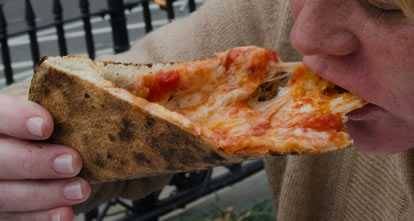
There is oil and a bit of sugar in the dough, and it is kneaded with aggression (what would you expect from New Yorkers?). Standard toppings are tomato sauce with noticeable oregano and garlic and mozzarella. That’s it. Pepperoni is probably the most common extra. Yes, you can get more stuff on top, but the basic pizza you get by the slice in hundreds of pizza joints in Manhattan is just sauce and cheese (at right, that’s Joe’s Pizza on Carmine at Bleeker, a quinessential example made in a tiny storefront). So simple, so satisfying. There is a slight crunch, a slight char, a chewy toothiness, and there are often drips of orange grease emanating from the tip. Only tourists blot the grease.
New Haven White Clam Apizza
There are several interesting characteristics of New Haven apizza (pronounced ah-PEETS), as it was called by the locals in their colloquial Italian-American.

The most famous, at Frank Pepe Pizzeria Napoletana and Sally’s Apizza, a few blocks apart on Wooster Street, are baked in coal-fired brick ovens. The crust is thin, stiff with a crunch and a light dusting of cormeal on the bottom to act as ball-bearings, and chewy on the top. Some call their crust Neapolitan, but the dough bears little resemblance to authentic Neapolitan pizzas from Naples (above). The most distinctive local species, and New Haven’s most important contribution, was invented by Pepe’s, the white apizza (at right), adorned with fresh littleneck clams, chopped garlic, olive oil, oregano, and Romano cheese. If you don’t like semi-cooked garlic, don’t order it.
Mozzarella cheese, called mootz, is not served on a plain pizza in New Haven as it is everywhere else in the US. In New Haven a plain apizza is crust, tomato sauce heavy on the oregano, and some grated Romano cheese. You want mootz? You gotta ask for it. Capiche?
Chicago-style Pizza a.k.a. Deep Dish Pizza a.k.a. Pan Pizza, a.k.a. Chicago Deep Dish Pan Pizza, and its Goofy Cousin, Stuffed Pizza
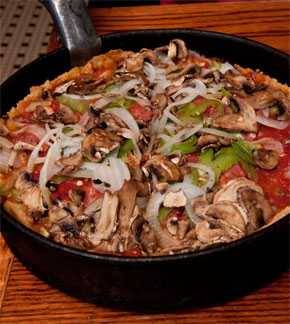
A cross between a pizza and a tart, Chicago Deep Dish Pan Pizza is a knife and fork a pie. Come to think of it, most other pizzas, because they are flat, should not really be called pies, should they?
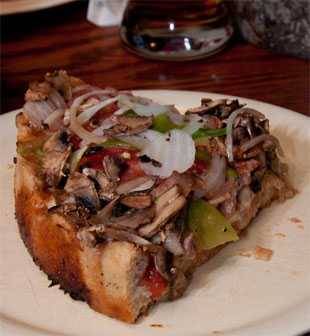
Pizza fans either love or hate Chicago Deep Dish Pan Pizza, and too many take potshots based on one tasting experience in a tourist trap where the specimen usually is a heavy thick soggy casserole made with bread dough, stringy plastic cheese, and cheap sauce. New Yorkers hat it, naturally.
The best are made in well oiled black pans with 2″ or higher sides, but if you wish to make one at home you can use a frying pan, a cast iron pan, or a springform pan.
Chicago Deep Dish Pan Pizza begins with a thick well-oiled dough, mostly made with wheat flour, that cooks up flaky. Some places mix in corn meal, but that’s not for me. I like my crusts to be pizza crusts, not cornbreads. The bread is about 1/2″ thick on the bottom and the dough is pushed up the sides of the pan in order to form a levee to hold in the toppings. From there it is built in layers in the opposite order of a normal pizza. First goes thin sliced cheese mix, a whole milk mozz, add parm to mine please, and cover the entire surface of the bread to keep it from getting soggy. Many restaurants use way too much cheap cheese chosen for its stringiness. A thin layer is all that is needed.
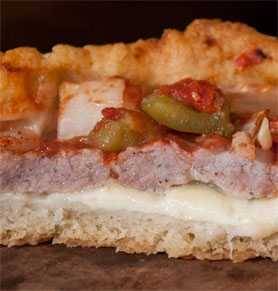
Then goes down a layer of fennel laced Italian sausage sans casing, patted into an unbroken layer about 1/4″ thick and spread to cover the cheese entirely. Then a 1/2″ layer of crushed whole plum tomatoes, peeled and drained so they are not to watery. Almost all restaurants use canned tomatoes to insure this layer is consistent year round. Some places use pre-mix pizza sauce, but the brightness and acidity of uncooked tomatoes is needed to cut the fats. Then a layer of fresh herbs, especially oregano, followed by thin sliced onions, green bell pepper, and mushrooms.
When you order this pie in a restaurant, expect it to take as long as an hour if it is made from scratch. And plan on 2 to 3 slices per person max. I often hit the wall after one! My faves? (1) Burt’s Place in north suburban Morton Grove, (2) Pizzeria Uno, photos above, and (3) Lou Malnati’s at right.
Burt’s is Place is a heftty drive from downtown and nearly impossible to get into, but if you can it is a trip. A genuine aging hippie, Burt cuts no corners, takes no shorcuts, uses only fresh ingredients, and hand crafts every pie. They are simply amazing.
As for Uno, the pictures above are the “Numero Uno” from the original Uno in Chicago. I have never eaten at one of the many Uno Chicago Grills around the nation or tasted their frozen pizza, but I am told there is a huge difference. Edward Heller, artist and self proclaimed deep dish pizza enthusiast, explains: “Only the original locations of Pizzeria Uno and [Pizzeria] Due in Chicago serve the authentic Chicago Deep Dish pizza that originated here back in 1943 as a collaboration by Ike Sewell, Ric Riccardo, and Rudi Malnati. The kind of pizza served at Uno Chicago Grill [franchises areound the nation] more resembles something served up by Pizza Hut. Please do yourself a favor and when you visit [Chicago], plan to stop by Pizzeria Uno (at 29 East Ohio) or Pizzeria Due (a block away at 619 North Wabash Avenue) and get the REAL thing before you pass judgment on Chicago Deep Dish Pizza.” A big Amen from this Chicagoan.
Stuffed Pizza. There is a goofy sub-species of the Chicago Deep Dish: The Stuffed Pizza. It’s assembled like a deep dish but the tomato sauce is withheld, then a thin layer of dough is placed on top and pinched to join the top lip, which is then enrobed in the thick red sauce.
The most popular practitioner is Giordano’s with more than 55 locations in Illinois and Florida, but my preference is Bacino’s (4 locations), shown here. That said, I’m not a fan of double-crusted pizza. They all seem to suffer from the same fatal flaws, soggy shell, top and bottom, insipid sauce, and waaaaay too much flavorless elastic mozzarella. Students of pizza should not confuse this with Chicago Deep Dish Pan Pizza as described above. It is far inferior to the real deal.
St. Louis Pizza
There are several unique aspects of St. Louis style pizza, the most popular of which is made by Imo’s, a 100 store(!) chain, all within a short drive from the Gateway Arch. Let’s start with the round, thin, unleavened, tortilla cracker-like crust with no puffy edge. Then there’s the slightly sweet tomato sauce. Top that with the unique three-cheese blend called provel (provolone, Swiss, and white cheddar) that gives the finished product a creamy flavor, and no strings. Around the nation, pepperoni is the most popular meat, but in St. Louis, sausage and/or bacon are the most popular add-ons.
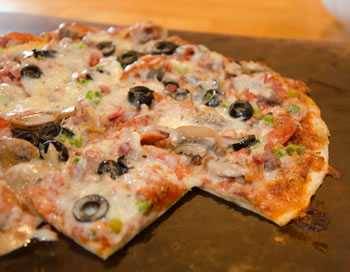
Founded in 1964 by a linoleum and tile setter named Ed Imo and his wife Margie, they cut their pizza just like he cut linoleum, in squares, not the normal pie shaped wedges. Called “party cut” there are lots of small pieces for everyone. I hate it (it is also popular for thin crust pizzas in Chicago). I mean, if you don’t cut it in wedges, you can’t really call it a pie, can you? That said, provel gives these pies, ummm, disks, a surprisingly tasty alternative to the same-old same-old around the nation. Locals love this breed, outsiders are aghast. Writing in USA Today, Larry Olmsted said “Comparing it to great New York or New Haven-style pizza is just like comparing White Castle hamburgers to those at a steak house.” I say it’s morelike comparing beef to lamb. Taste is, after all, a matter of taste.
Easter Pizza
Italian-American families call it Easter Pizza, and it is made just once a year, between Palm Sunday and Easter. There are many variations on the theme, but the ones I have known are the children of a orgy between a calzone, Chicago stuffed pizza, a quiche, and a meat pie. There is a slightly sweet dough filled with a blend of ricotta cheese and cured meats like Italian sausage and ham. The whole thing is covered with more dough.

There are many variations, of course, with a wide range of cheeses (mozz, fontina, asiago, pecorino, parm) and meats (prosciutto, pepperoni, bacon, soppresata, salami). Some recipes include spring onions, garlic, and even dried fruits, and surprising touches like lemon zest in the dough. The dough on top can be a solid sheet, but I’ve seen pictures of it made in a pie pan and cross hatched like a blueberry pie. It can be eaten hot, but often it is prepared in advance, chilled, and placed on the table before mass, to be served after church, with coffee. But anyone who has had one in his fridge will tell you, it makes a killer midnight snack. The one shown here is the handiwork of my sister-in-law Therese Tortorello of Elmhurst, IL. She is also the author of the Sicilian pizza, above.
To Italians, Easter Pizza has become an annual fleeting symbol of spring, like tulips and daffodils, and a traditional part of an important religious holiday ritual.
Al Forno Style Grilled Pizza
First we need to understand that there is “pizza on the grill” and “grilled pizza”, a subtle nomenclature difference, but very very important. Pizza on the grill means that you prepare the pie as it is would be prepped in a pizzeria, form the crust from raw dough, add the toppings, place it on a pan or stone, put it in a hot grill, close the lid, and bake. As such, it is not really a species. Any species can be cooked on a grill.
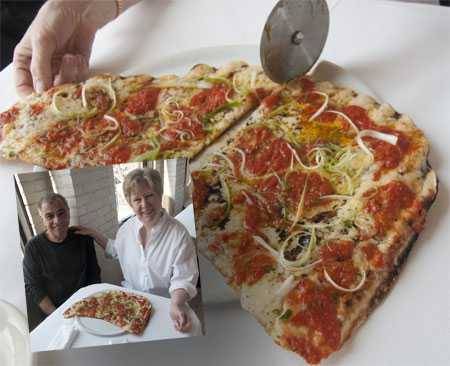
True Grilled Pizza, on the other hand, is a unique preparation pioneered by Johanne Killeen and George Germon at Al Forno restaurant in Providence, RI, around 1981. An ball of dough is oiled heavily, pushed out with fingers into an asymmetrical shape, and then it is placed right on hot grill grates just a few inches above the coals. No toppings. It is toasted til golden on one side and flipped. Because there is no lid, just a few toppings are added, and they cook while the bottom is toasted darkly and slightly charred. This produces a heavenly thin, crunchy crust, perhaps 1/8″ at most, with simple, very fresh flavors that come in bursts. If you make it at home, you must not put too much on top or you run the risk of not cooking the toppings properly before the bottom burns. The photo here shows their Margarita pizza made with their trademark thin crunchy/chewy crust, fontina and Romano cheese (no mozz), a raw tomato sauce with cooked garlic and just a few herbs, high quality extra virgin olive oil, and thin ribbons of scallions. Note that they call it Margarita, not the traditional spelling “Margherita”, because it does not have mozzarella and the process is so different. They make break tradition, but they respect it. Watch for more on how Al Forno does it and my recipe for how you can do something close at home, coming soon.
Designer Pizza (a.k.a. California Pizza)
This is a catchall for the creative style of pizza toppings popularized in the 1970s by Ed LaDou who worked with Alice Waters of Chez Panisse in Berkeley and in the 1980s with Wolfgang Puck at Spago in LA. They began adorning their disks with organic veggies like arugula, exotic mushrooms including truffles, every cheese you can think of, especially fresh goat cheese, figs and other fruits, poached eggs, and unusual sausages and meats such as smoked salmon. LaDou was also a player in the launch of the California Pizza Kitchen chain which spread the gospel nationwide.
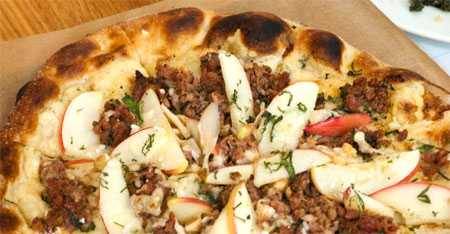
Chefs around the world now put everything you can imagine on their crusts, which can range from thin to thick. Among the most popular subspecies are the Barbecue Chicken Pizza with smoked gouda and barbecue sauce; Mexican Pizza with chorizo sausage and jalapeño; and Hawaiian Pizza with ham and pineapple, although some say it started in Germany!
Flatbreads and Cracker Crusts
In recent years fancy contemporary upscale restaurants have begun serving something they call “flatbreads”. They are a variation on the Designer Pizza with rigid cracker-like unleavened no-yeast crusts that crrrrunch. The one here, from Prasino in LaGrange, IL, is on organic whole wheat crust, and is topped with corn, pesto, caramelized onions, diced tomato, mozz, and is drizzled with balsamic vinegar.
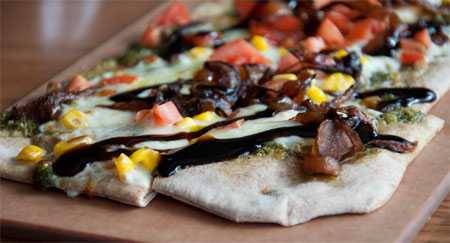
By not using the “p” word they can charge more and they won’t tarnish their hoity toity reputation. Don’t be fooled. They’re pizzas. But don’t avoid them either. They can be wonderful. This one was.
Greek Pizza
Most Greek-American cooks and restaurants make pizza just like all the other local pizzerias, but to me, and this is not a universal belief, Greek Pizza is made on puffed pastry rather than the normal breadlike dough, a recipe we first discovered in the fabled first edition of The New Moosewood Cookbook by Mollie Katzen. The toppings we favor include feta cheese, Kalamata olives, fresh tomato, green bell pepper, onions, and spinach. Katzen is vegetarian, so don’t tell her gyros meat is a fine addition. Alas, this wonderful style is very hard to find outside of home kitchens.
Japanese Pizza Bread
Apparently there is a popular variant in Japan called Pizza Toast. Craig Mod wrote about it in Eater and photographed it (below) as “a fat slab of white bread, some tomato sauce, cheese, maybe some onions and green peppers. After that it’s up to the chef. It is a hug produced in a toaster oven.” Apparently it is served mainly at a type of small old-style Japanese cafe called a “kissa.”
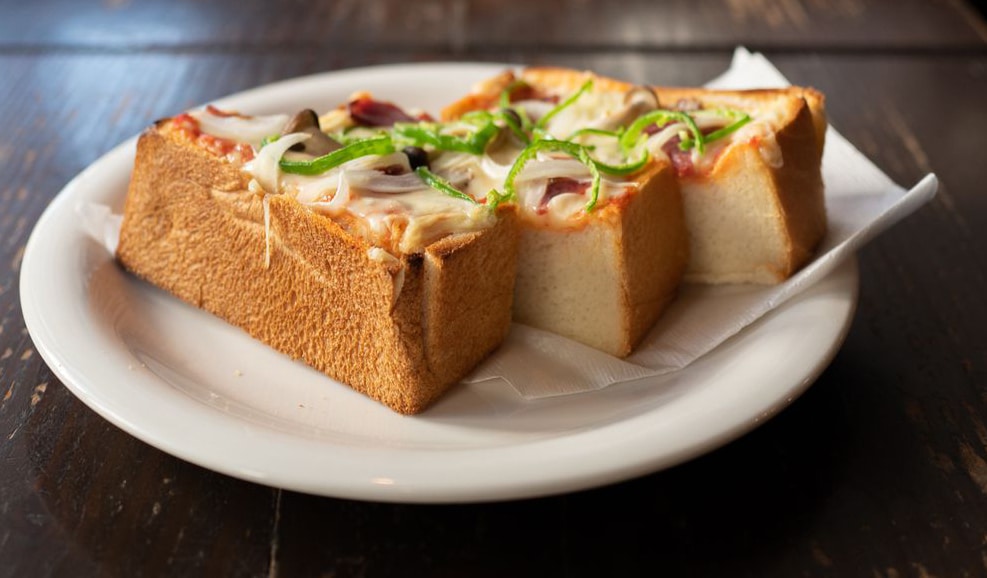
Khachapuri from the Republic of Georgia
It starts with a white flour dough in either a disk shape or sometimes a canoe shape, covered in cheese, and sometimes adorned with an egg that sets up while baked.
Dessert Pizzas
You would be surprised what you can make for dessert with pizza dough. I made the one below by baking a naked Neapolitan crust, spreading on it mascarpone and Nutella (50:50), popped it back in the oven to warm the topping, then finished it with fresh strawberries and powdered sugar. Oh my!
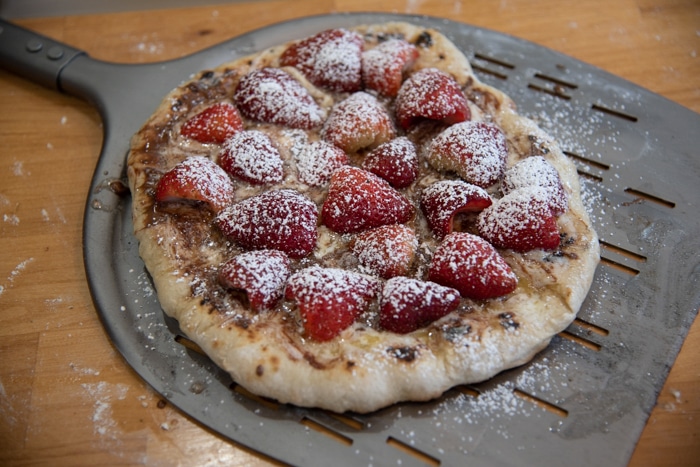
Are these pizza species?
Then there are the English muffin pizzas, French bread pizzas, tortilla pizzas, pita pizzas, and bagel pizzas. If you accept my contention that it is the dough that determines a species more than the toppings, then they just might qualify. What do you think?



High quality websites are expensive to run. If you help us, we’ll pay you back bigtime with an ad-free experience and a lot of freebies!
Millions come to AmazingRibs.com every month for high quality tested recipes, tips on technique, science, mythbusting, product reviews, and inspiration. But it is expensive to run a website with more than 2,000 pages and we don’t have a big corporate partner to subsidize us.
Our most important source of sustenance is people who join our Pitmaster Club. But please don’t think of it as a donation. Members get MANY great benefits. We block all third-party ads, we give members free ebooks, magazines, interviews, webinars, more recipes, a monthly sweepstakes with prizes worth up to $2,000, discounts on products, and best of all a community of like-minded cooks free of flame wars. Click below to see all the benefits, take a free 30 day trial, and help keep this site alive.
Post comments and questions below
1) Please try the search box at the top of every page before you ask for help.
2) Try to post your question to the appropriate page.
3) Tell us everything we need to know to help such as the type of cooker and thermometer. Dial thermometers are often off by as much as 50°F so if you are not using a good digital thermometer we probably can’t help you with time and temp questions. Please read this article about thermometers.
4) If you are a member of the Pitmaster Club, your comments login is probably different.
5) Posts with links in them may not appear immediately.
Moderators